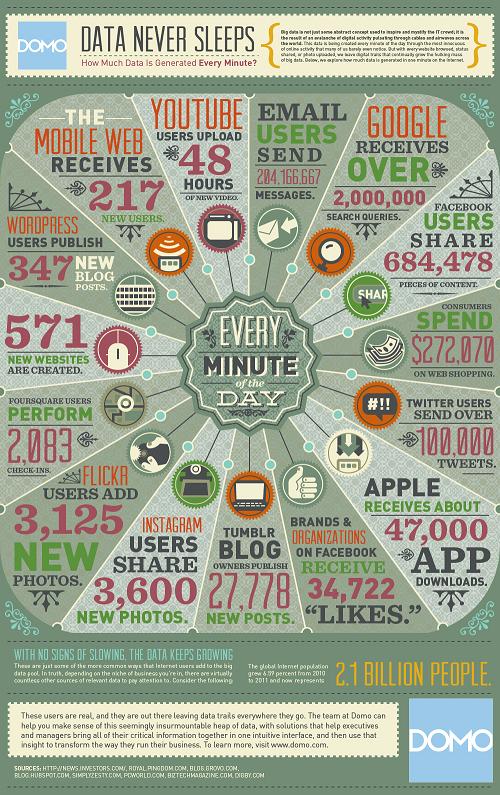Check out this infographic by Domo on how data is consumed. The pic speaks for itself - click on it for a more detailed view.
Alan Turing: Cracking Codes and Taking Names
Every time you see a ridiculous movie scene where someone cracks a complex code, think about Alan Turing. He was born 100 years ago today and he's left an impressive legacy. He helped design early computer circuits, including his own Automatic Computing Engine (ACE), which was one of the fastest in the world. Famously, it helped to perform the many precise measurements needed to analyze plane wreckage of the time. He helped cracked the German Engima codes to hamper communication between our enemies in World War 2.
Just in case the machines that he helped design happen to take over the world, Turing also designed his own test to help distinguish between artificial intelligence and human intelligence. If we have a text only interaction with a human and a computer, would we be able to distinguish the two from one another? We incorporate Turing's ideals unconsciously whenever we delete a spam email message for looking too robotic.
Besides, if Google does a Doodle about Turing, he has to be something, right?
#ScienceLooksGood - Space Theme for Your Computer
Lifehacker has an amazing space desktop theme available for Windows, MaC, and Linux. Check out their post here. It includes the above wallpaper plus customized skins and icons to make your desktop look like Spaaaaace! The following are included for Windows:
The Goodnight Tale wallpaper from DeviantArt
The Rainmeter system management and configuration utility for Windows
The Encoded skin for Rainmeter to get the date and weather
The Enigma suite for Rainmeter for the system stats on the right side of the screen
The Google bar for Rainmeter for the search bar in the upper right
StarDock's ObjectDock to replace the Windows taskbar
The Token icon set for the dock at the bottom
Check it out at Lifehacker!
Spaaaaace: NASA Landstat 40th Anniversary Celebration
 Haiti Earthquake 2010, via NASA
Haiti Earthquake 2010, via NASA
I'm proud to announce that on July 23rd, I'll be attending the 40th anniversary celebration of the NASA Landstat program! This event will be held at the NASA Goddard Space Flight Center in downtown Washington, DC.
The Landstat program is responsible for mapping the Earth's surface from space. This helps present a definitive view of the state of the world's assets, such as our forests and water. In addition, it's used to monitor events such as the image of the 2010 Haiti earthquake embedded at the top of this post. From the site:
Landsat satellites have taken specialized digital photographs of Earth’s continents and surrounding coastal regions for over three decades, enabling people to study many aspects of our planet and to evaluate the dynamic changes caused by both natural processes and human practices.
During my visit I'll be able to view the latest Landsat science and images, tour the Goddard center, make my own Landsat images, speak with Landsat mission scientists and engineers, and interact with other participants and NASA's social media team
I'll be participating through the same NASA Social program (formerly NASA Tweetup) that enabled me to view the last Space Shuttle launch in person last year. For my coverage on that historic event, see my posts here, here, and here.
I'll be tweeting from @ShareefJackson using the hashtag #NASASocial - be sure to follow me!
Tech Education: Take a Look, It's In a Book
Earlier this year, Kunta Kinte aka Geordi La Forge aka Levar Burton secured the @ReadingRainbow twitter account. He promised that a "disruptive reading initiative" would be arriving soon. It's arrived as an iPad app. And ... it's pretty good.
The app serves as a library of interactive books. The app itself is free, as well as one book download and introductory videos to the service. For additional content, users can subscribe for $10 every month or $30 every 6 months. I originally balked at the price, but the content is intuitively suited for a device such as an iPad - lots of sounds, videos, interative games, and much more beyond just a scanned PDF. It's basically like an enhanced version of Highlights for Children. The high level of quality makes it worth the price.
One big negative is the file size. It weighs in at just over 100MB, and can feel a little sluggish during operation. Since it's geared towards younger children, I don't see this being much of a problem. But for techies like myself, I'd prefer something a bit more slimmed down and speedier.
One improvement that I hope is in the works is interaction with physical libraries. Imagine if I could "check in" at the my local library with a service similar to Foursquare that's integrated into the Reading Rainbow app, and that results in extra awards or stickers. Even better: what if I could scan the bar codes of books that I read for other awards in the app? The possibilities are endless.
If you have an iPad, check it out by downloading here!



